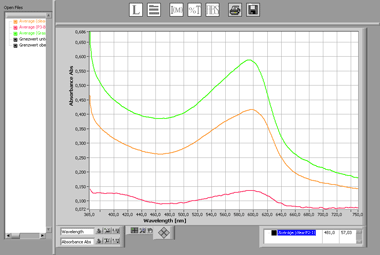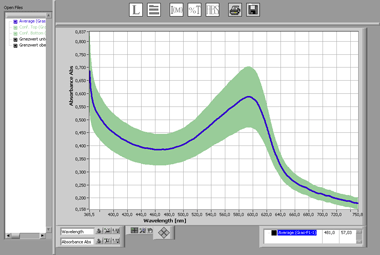UV-VIS Spectroscopy for Pollen Analysis
Classification of different Types of Pollen for Agriculture and Medicine
The determination of pollen concentrations increases in importance both in health and in the agricultural sector. Worth mentioning is the flight prediction with the taxonomy of pollen, which must include a clear separation to fine dust and other microparticles.
Another example is the measurement of local concentrations in plantations during the pollination phase, to ensure the likelihood of an optimal fertilization.
In addition to the image analysis method for which a high level of expertise is necessary, this task can be easily done using a standardized protein staining. For this purpose, the patent 14.09.2006 DE102005013623A1 describes a method in which an assignment of the pollen species can be made using the spectral differentiation.

Comparison of a protein staining from grass
pollen (green), Olea (orange) and birch (red).
The spectra are averaged curves of10
measured pollen, respectively.
© A.S. & Co. GmbH

Evaluation of protein staining in 25 grass
pollen showing mean value curve and
confidence interval.
© A.S. & Co. GmbH
The above calculated courses from series of curves show comparisons of different types of pollen and classify the species on the basis of their individual response to the reagent. For this method a simple laboratory microscope with a relatively low resolution spectrometer is perfectly adequate. Thus, this method of investigation is a quick inexpensive alternative to imaging techniques. Furthermore it is the ideal complement for an additional characterization. Microscope spectrometers from A. S. & Co. are economically attractive for this task and can be perfectly configured for various kinds of measurements.

Complete system of A. S. & Co. consisting of a suitable integrated spectrometer and the controller for
controlling the shutters and filters of manual microscopes.
© A.S. & Co. GmbH
Construction of a compact spectrometers
The complete system of A. S. & Co. consists of a suitable integrated spectrometer and the complements for optimum handling of pinhole adustment. For use with manual microscopes controls for motorized filter changer and light shutters can be added as well as switchable illumination systems. Thus, the automation of predefined procedures for routine measurement can also be implemented at a simple microscope.